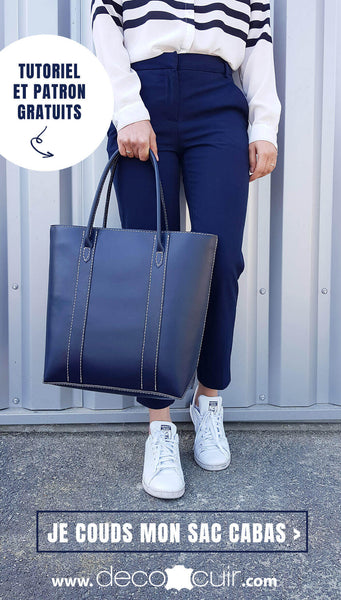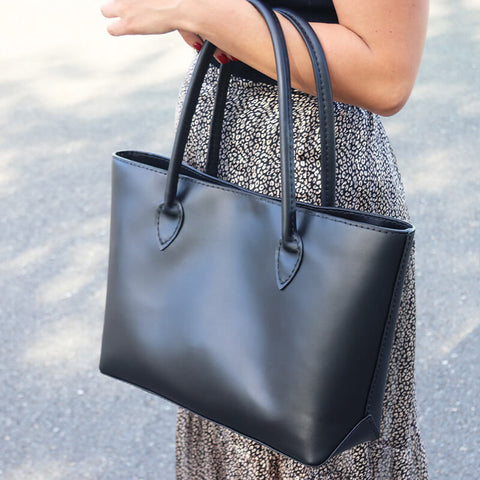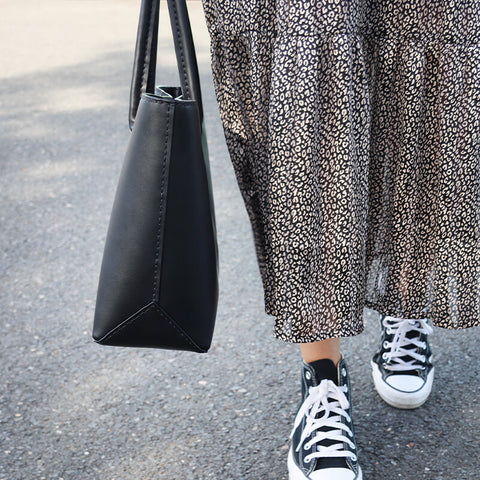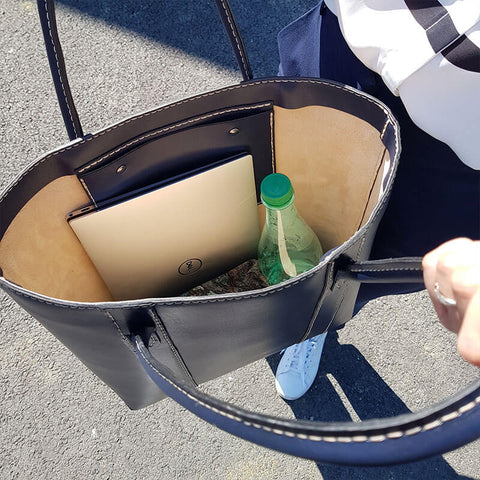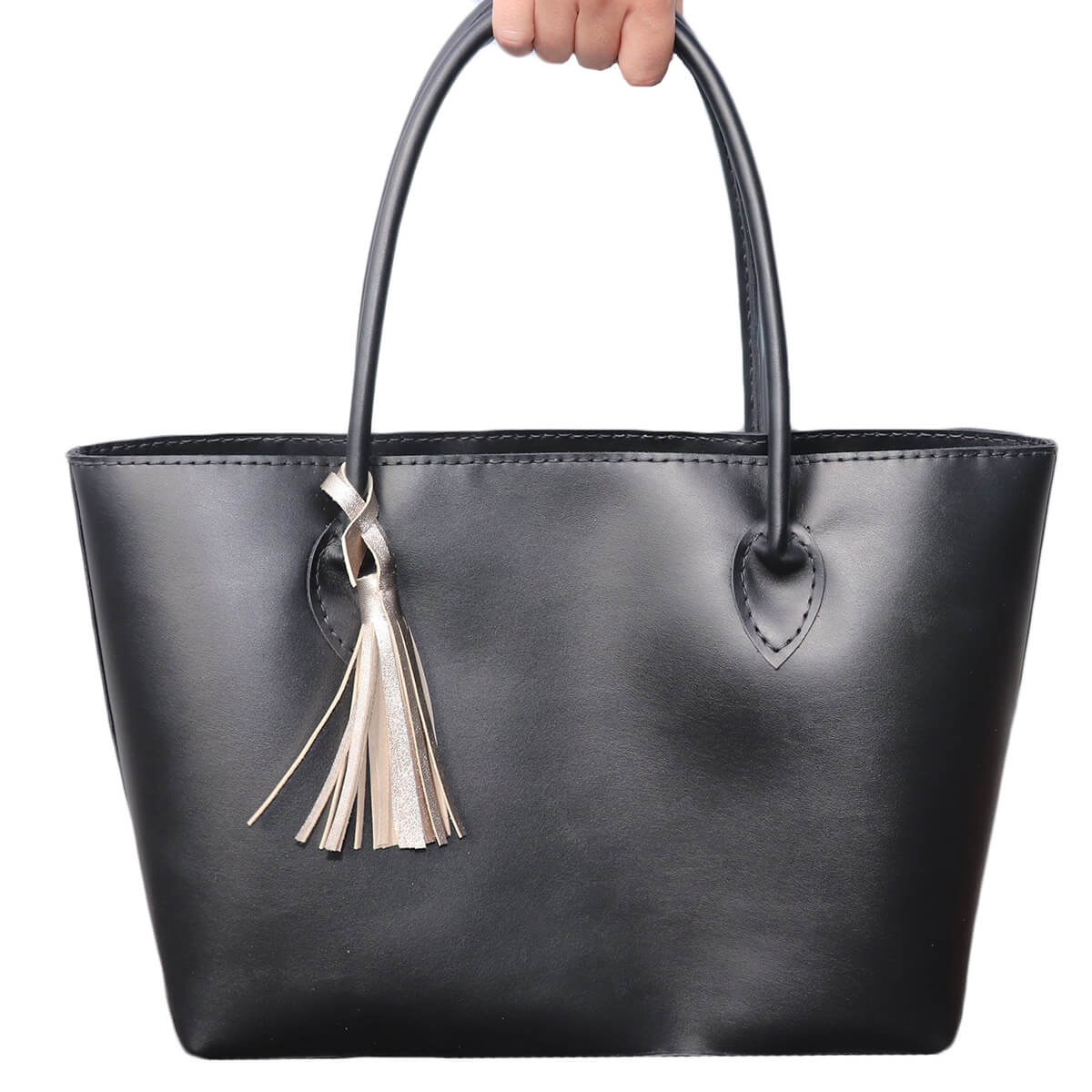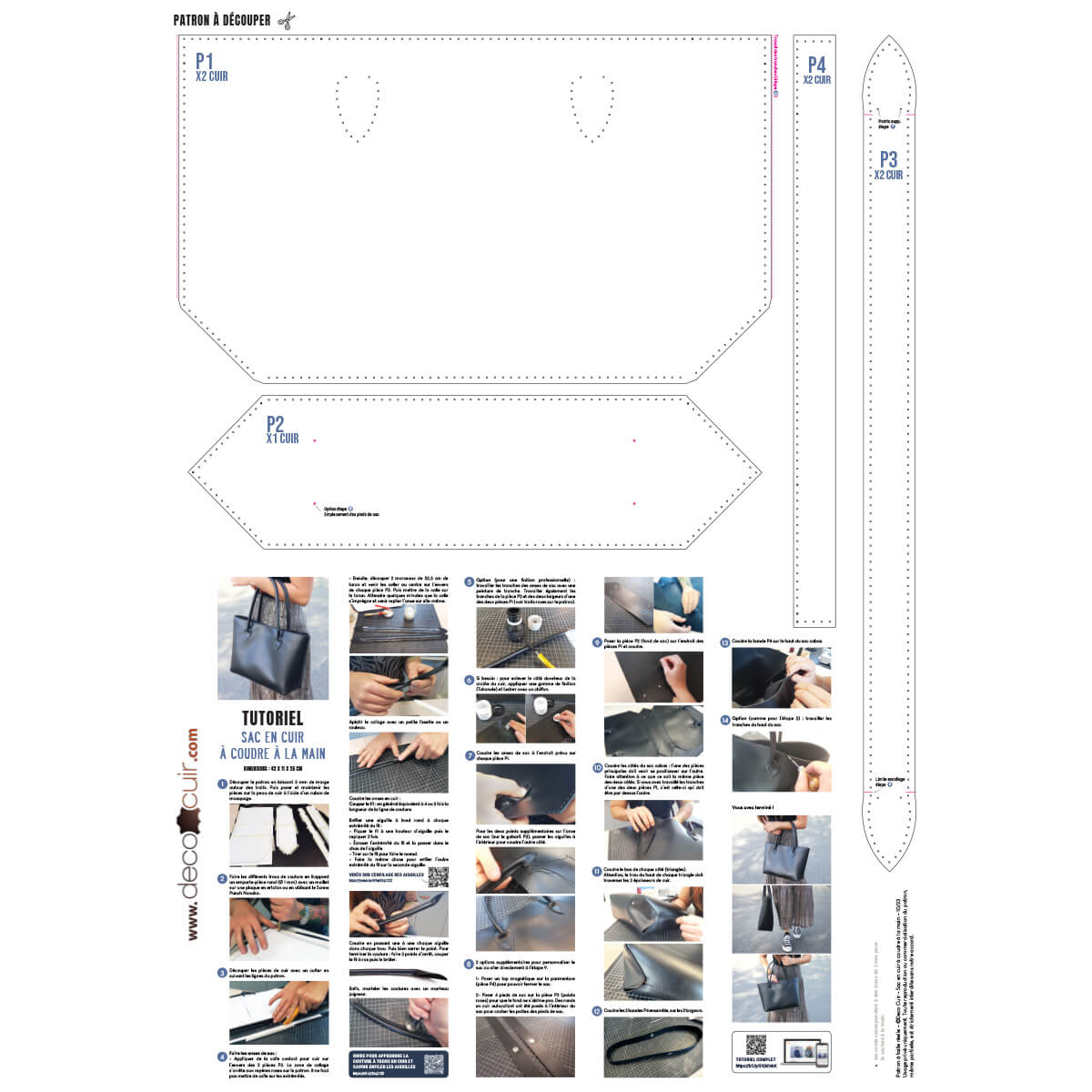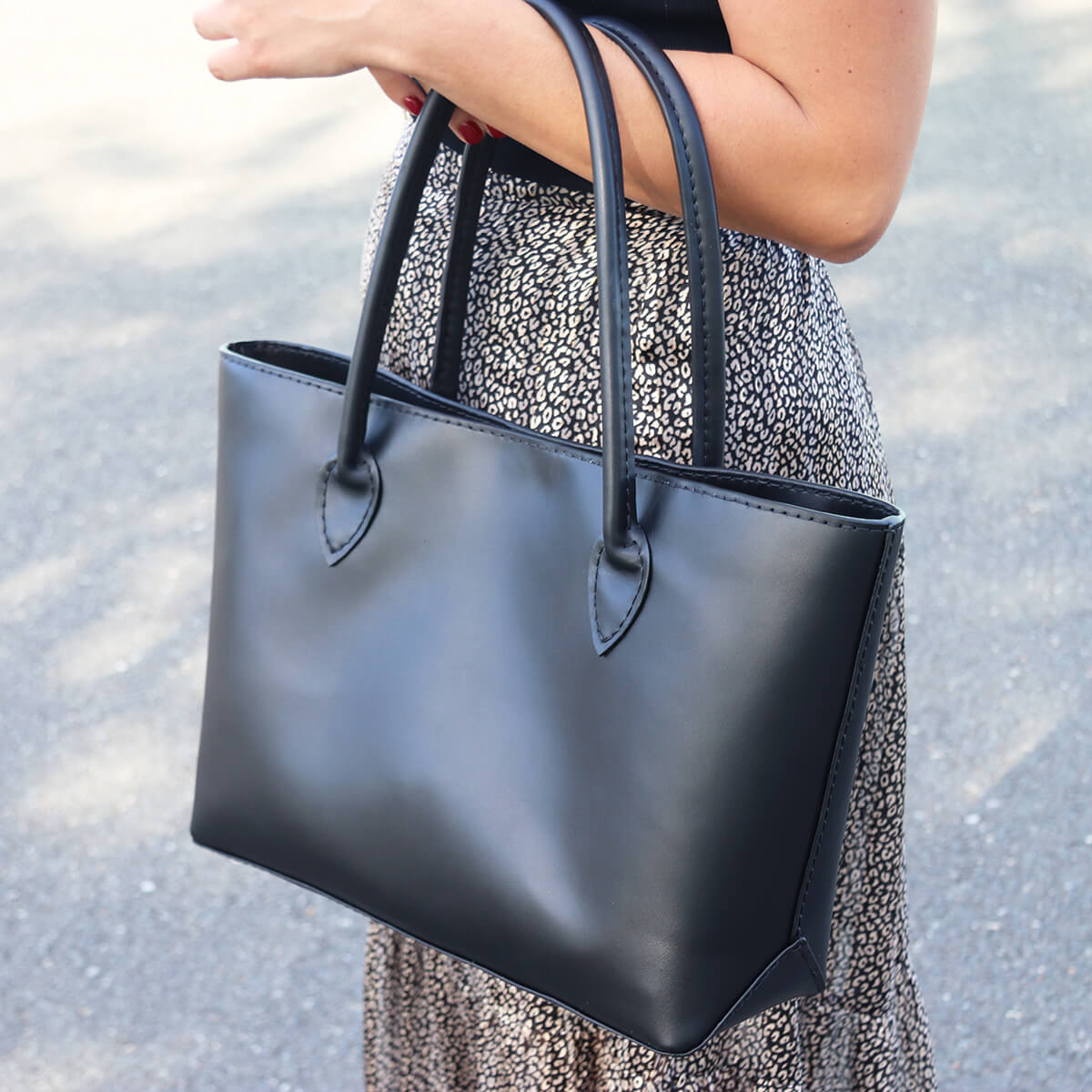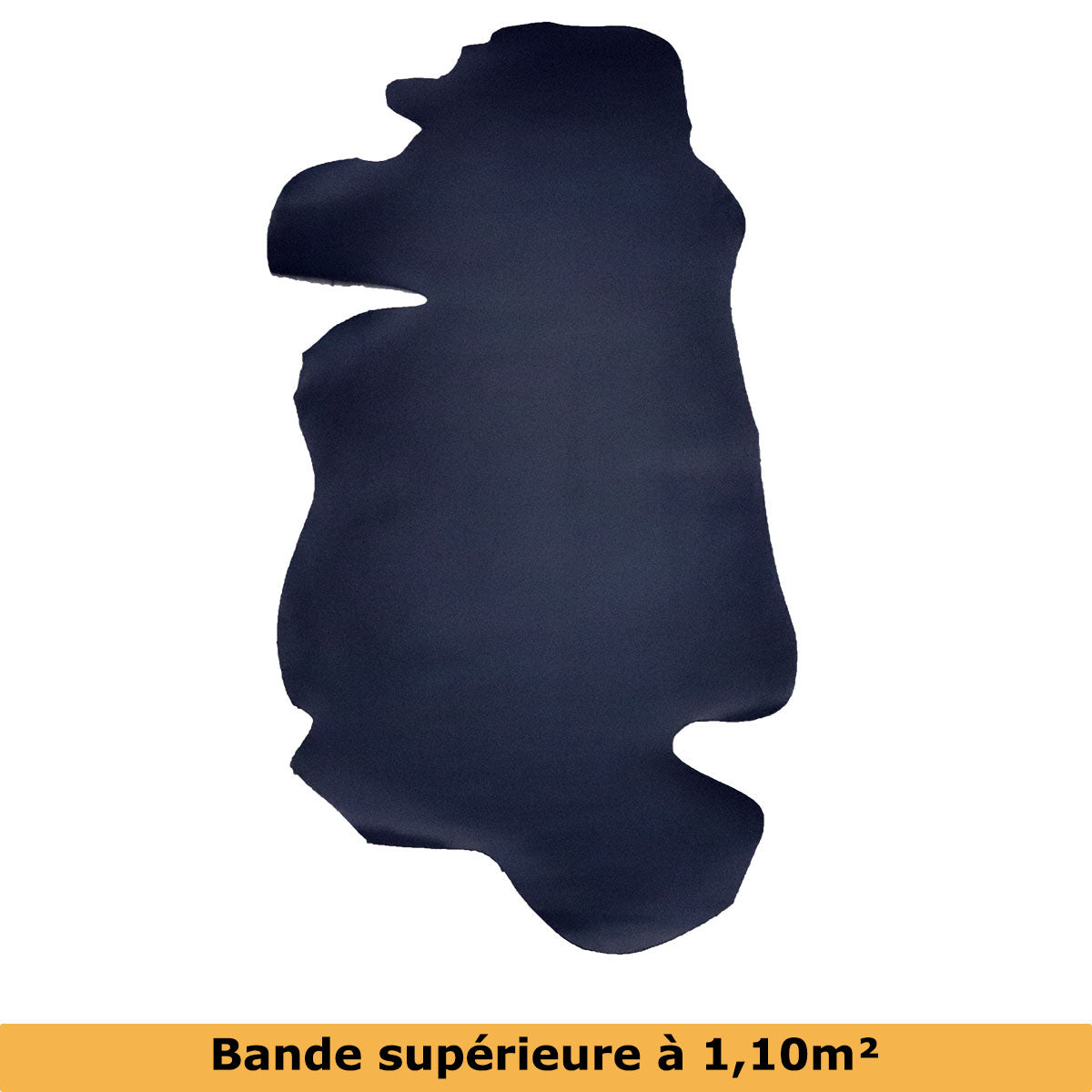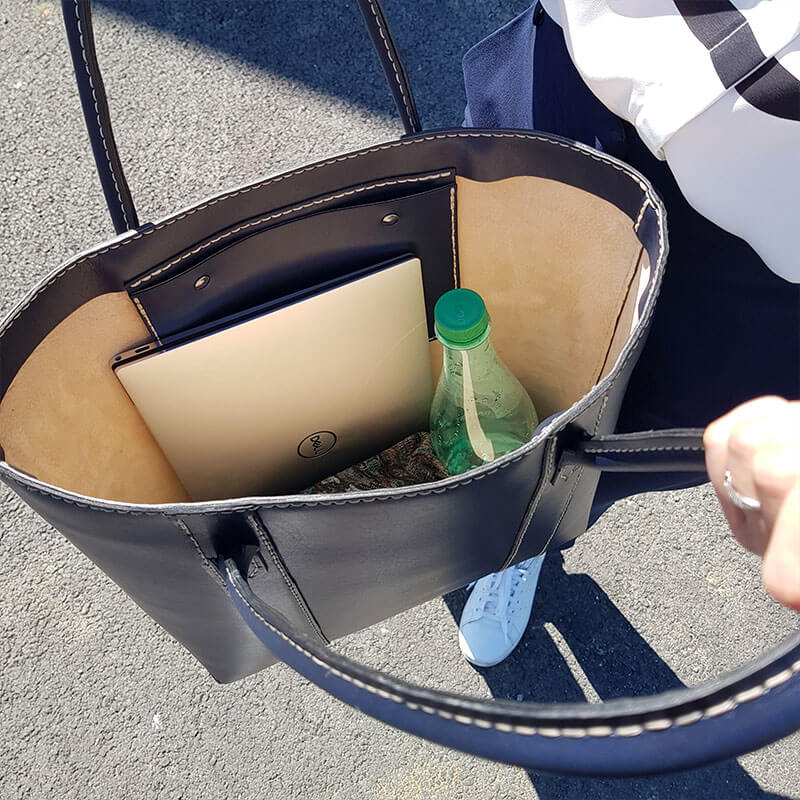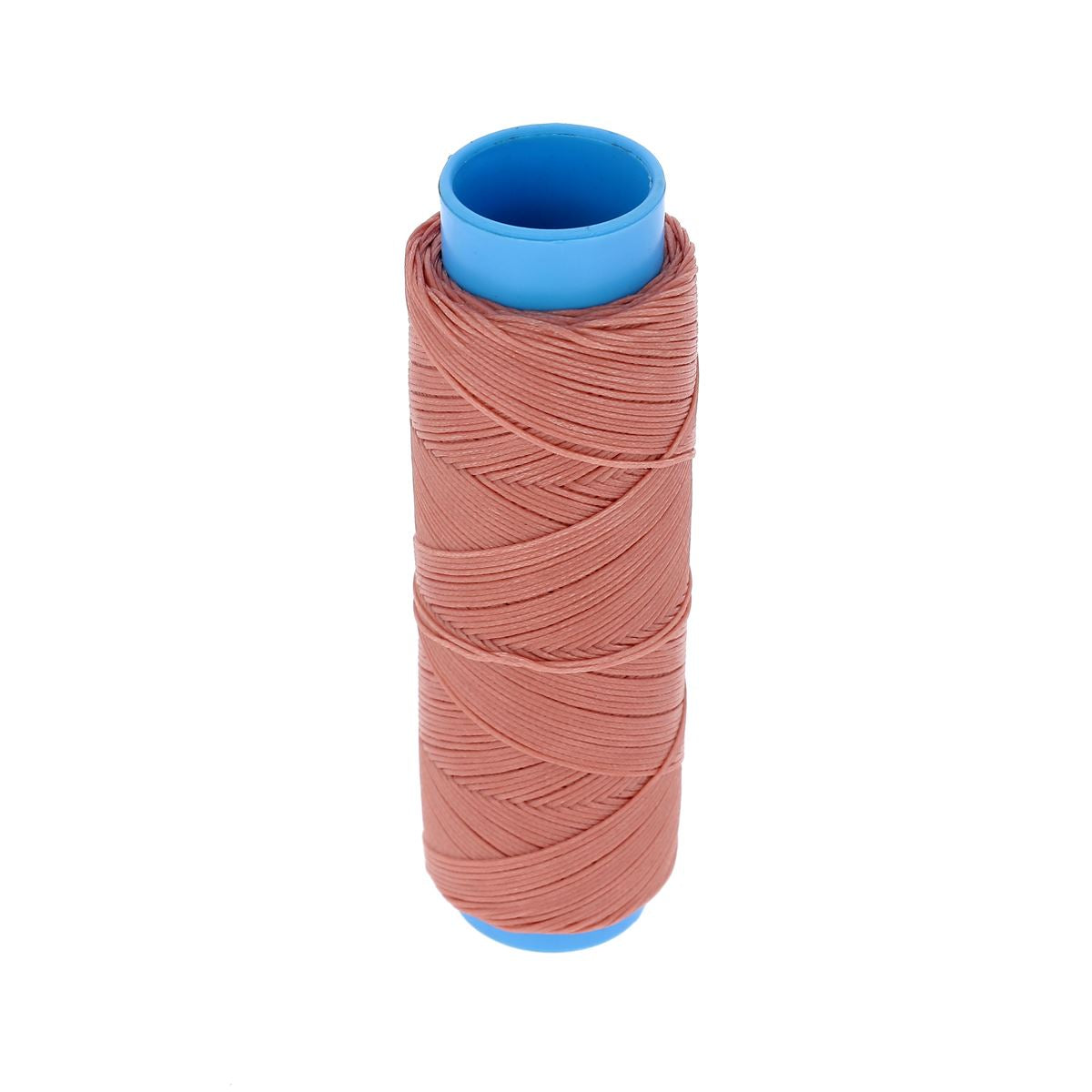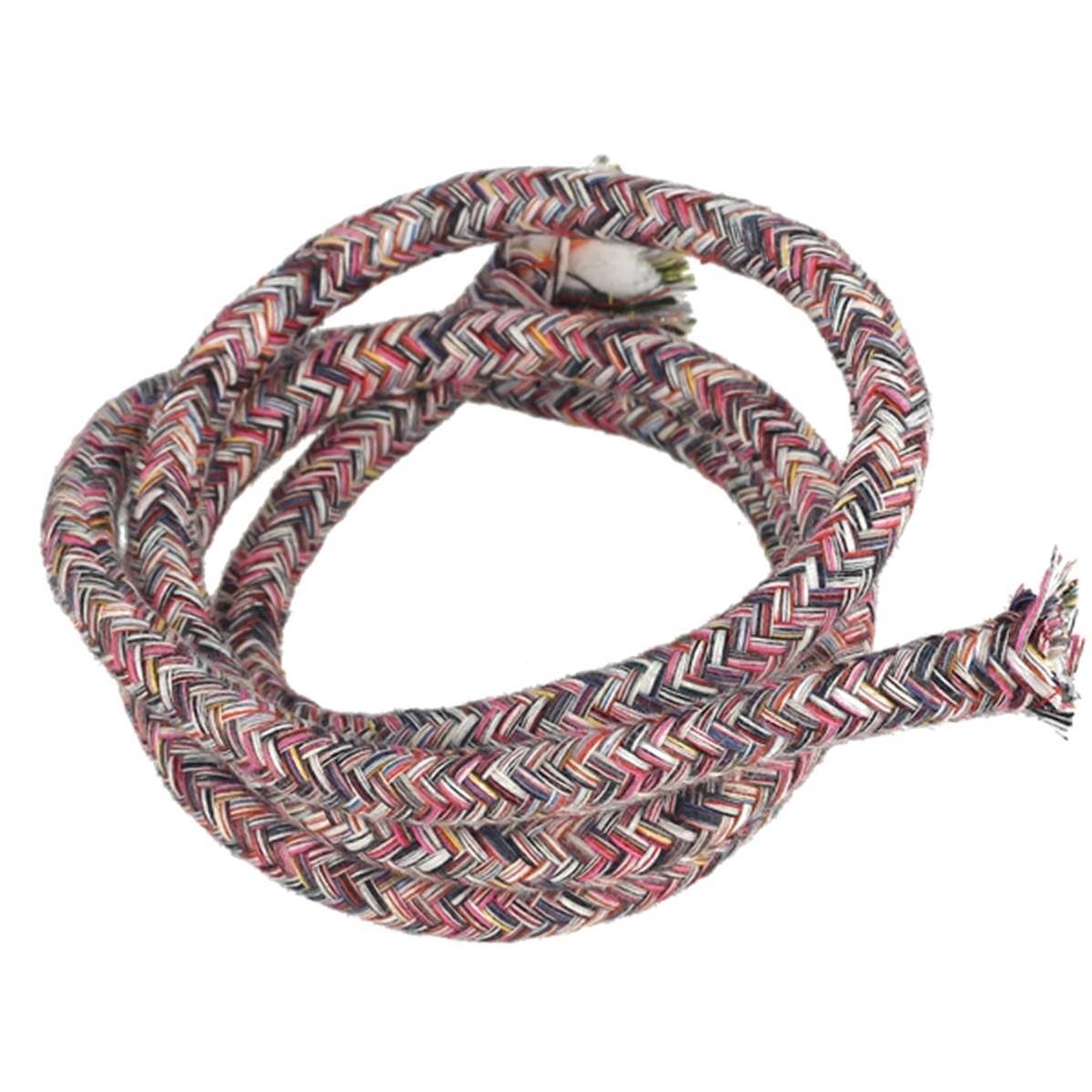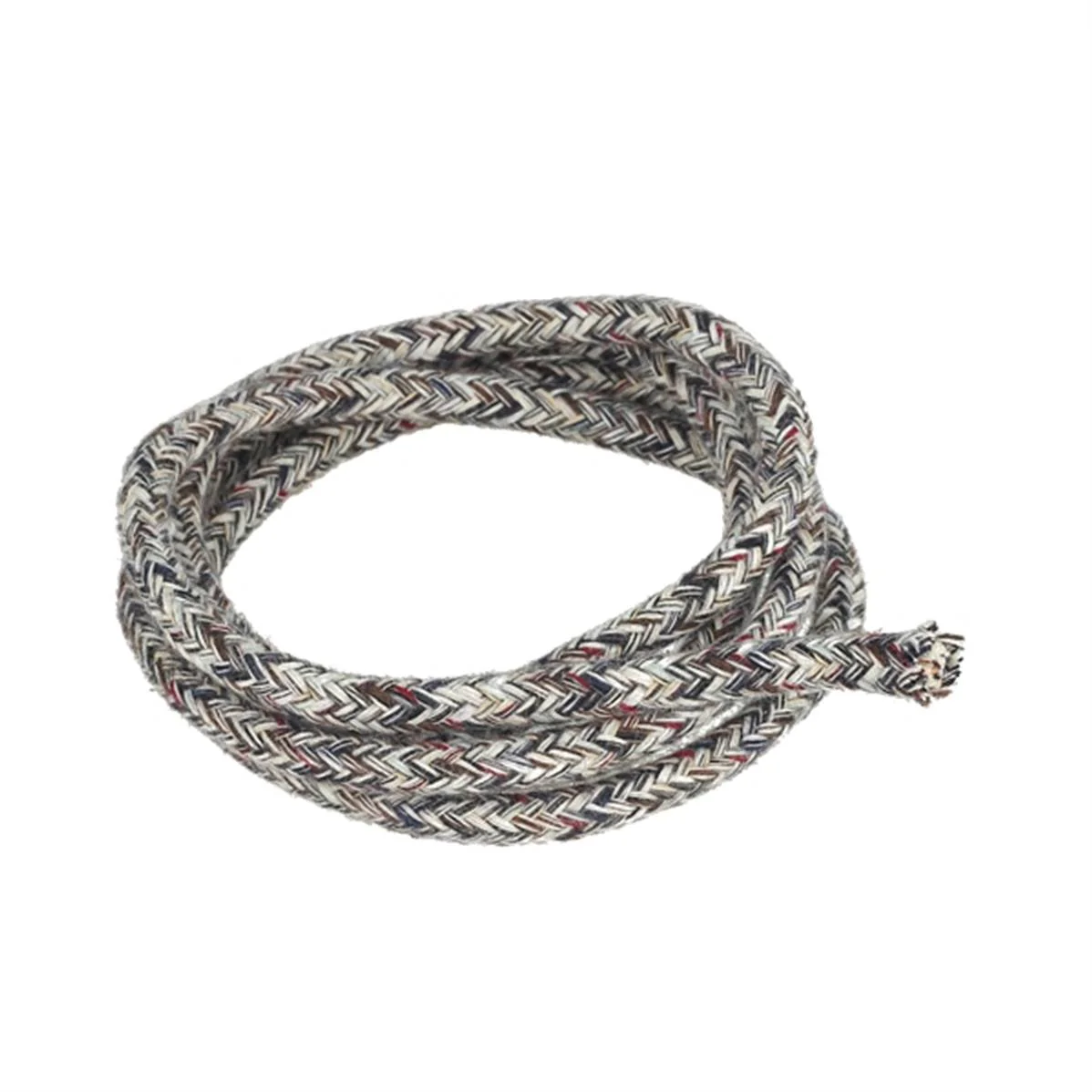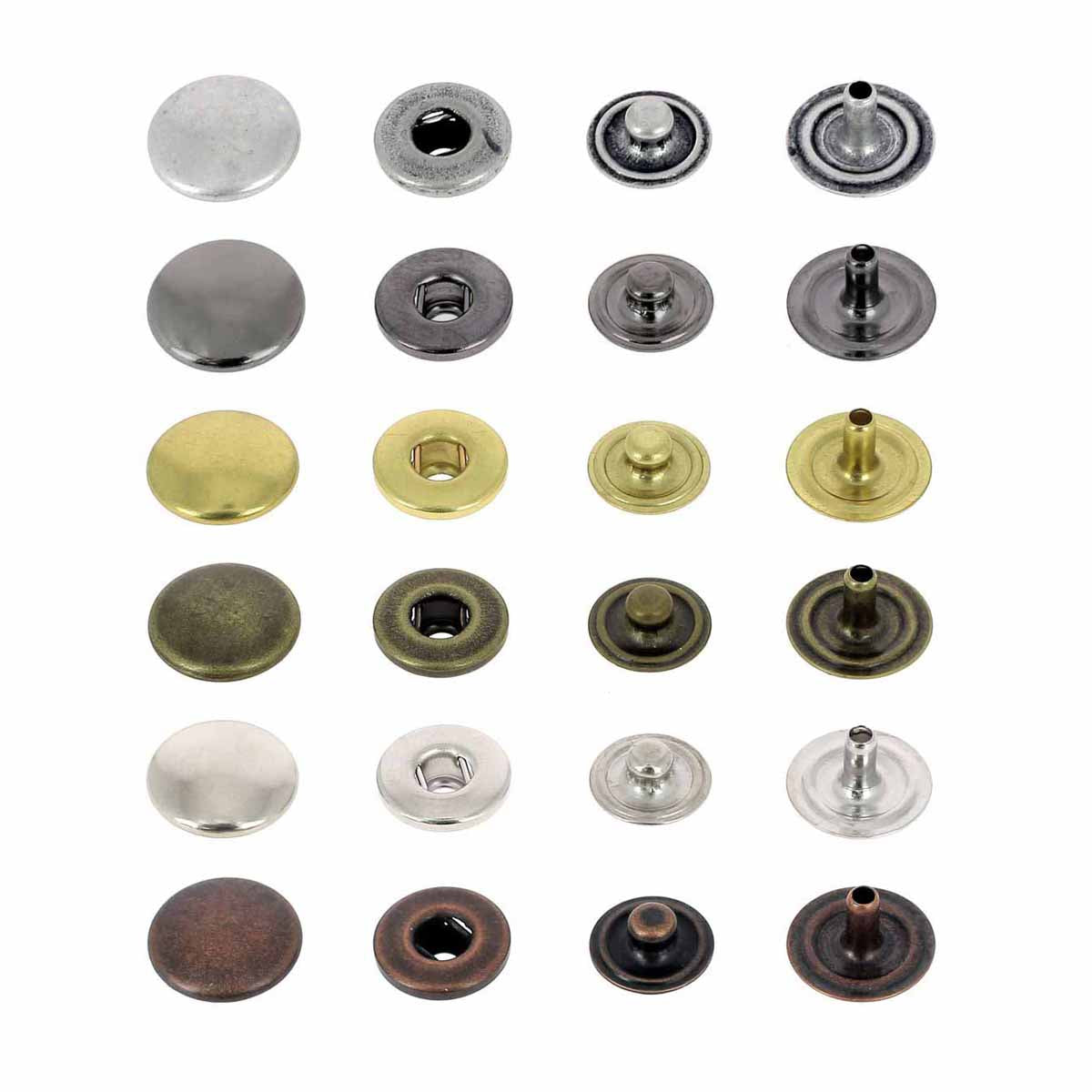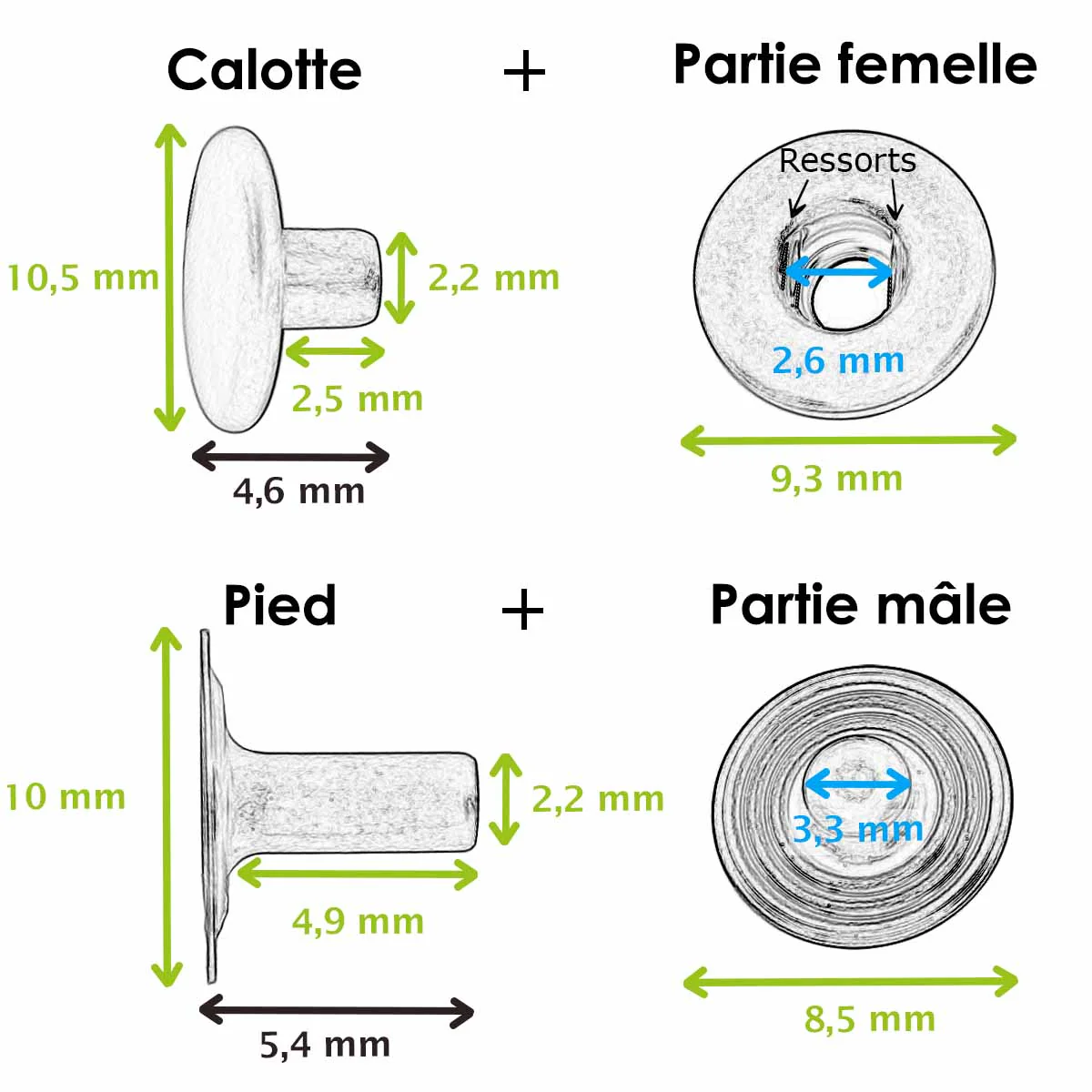THE NECESSARY MATERIALS
- 1 strip of VVN TANAO NAVY BLUE OR WILD leather - Thickness 1.5 mm - minimum 1.25 m²
Here we used a dyed vegetable tanned leather hide from our range, priced at over €100. For smaller budgets, we recommend selecting a firm or semi-soft semi-firm leather hide with a minimum thickness of 1.4 mm and a maximum thickness of 1.9 mm (e.g. coated split leather, patent split leather, cowhide, etc.).
- 1 VELVET - NATURAL suede pigskin split leather. Minimum recommended surface area: 0.55 m²
- 1 spool of 500 m of braided and waxed polyester thread - diameter 0.80 mm
- 1 jar of tokonole - Leather finishing gum - 120g OR 1 jar of edge finishing (if you choose mineral tanned leather).
- 2 meters of strand for bag handle - Diameter 6 mm
- 2 MINI GUN BRASS snap fasteners - 10.5mm diameter OR 12.5mm diameter magnetic snap fasteners (no installation tool required).
- 1 jar of 250 ml of water-based CONTACT ADHESIVE
- 2 round-tipped needles
- 1 round cookie cutter, 1.5 mm in diameter
- 1 mallet
- 1 cutter and rotary cutter
OPTIONAL : texon and bag feet for the bottom of the bag and 4 magnetic tops if you want to be able to close the tote bag.
BEGINNER: HAND SEWING LEATHER MADE EASIER
For beginners, we offer a simplified hand sewing technique called "hole sewing." You won't need any special knowledge to successfully make the bag. Discover in the guide below the essential points to know before embarking on simplified hand sewing.
SEE THE GUIDE > 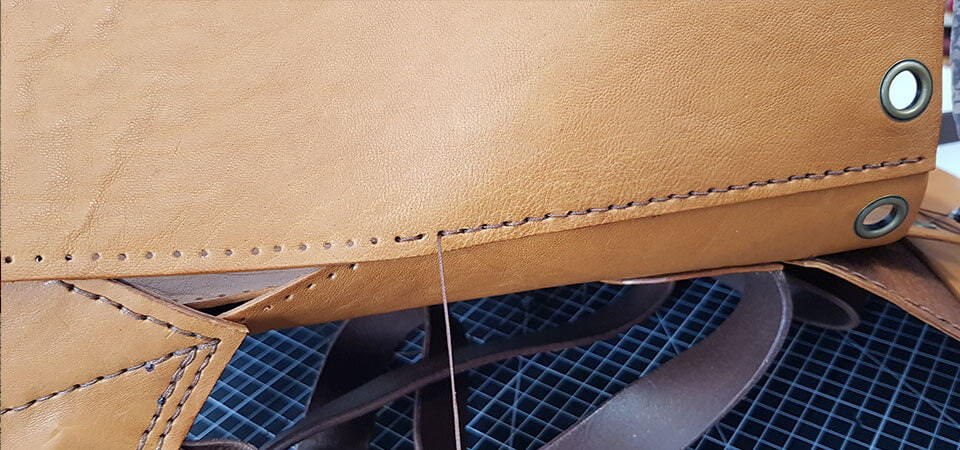
EXPERT: SADDLESTITCH LEATHER SEWING
Those with more experience in leatherwork can sew the tote bag with a saddle stitch. The saddle stitch is the most popular stitch among leather lovers because it is the strongest stitch.
SEE THE GUIDE > 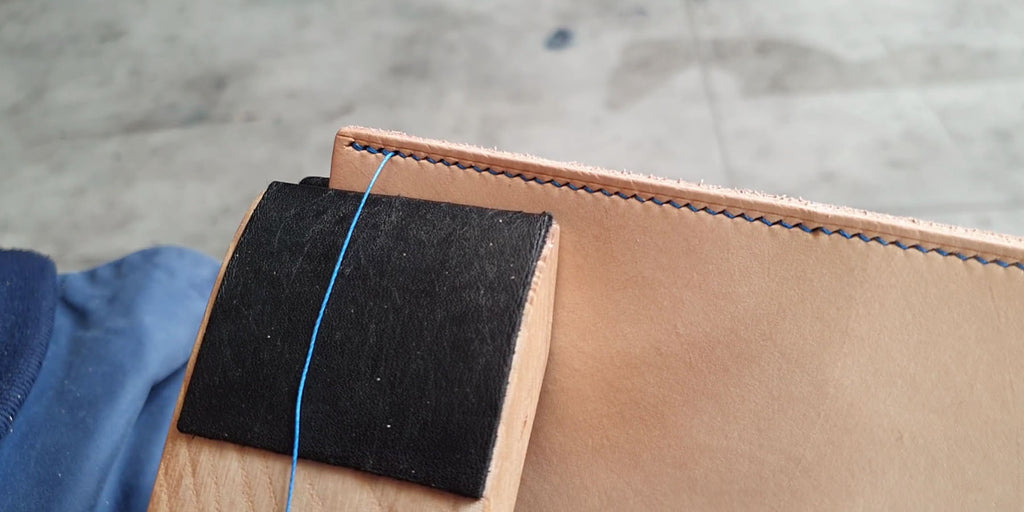
VIDEO
1. PRINT THE PATTERN
- Print the actual size tote bag pattern (download it in the tab at the top of the page).
- Assemble and cut out the pattern, leaving a 5 mm margin around the lines.
- Then place and hold the pieces on the leather skin using masking tape.
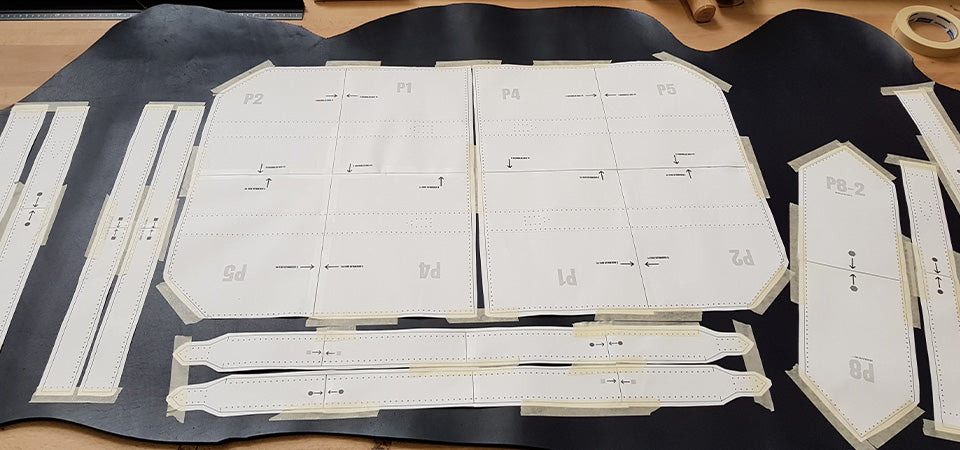
2. PUNCH THE SEWING HOLES
Make the various sewing holes by hitting a round punch (Ø 1 and maximum Ø 1.5 mm) with a mallet.
The center to center distance of the stitching holes is 6.5 mm. You can use the Deco Cuir 5-piece removable punch to speed things up.
Adjust the last points with a simple round cookie cutter.
SEE THE ARTICLE >
Do not drill or cut out parts P8 and P7 (large model) / P6 and P7 (small model) which will be doubled in step 6.
*For saddle stitching, you must mark the stitching points with a punch after cutting out and/or assembling the pattern pieces (step 3). Don't hesitate to consult our complete guide.
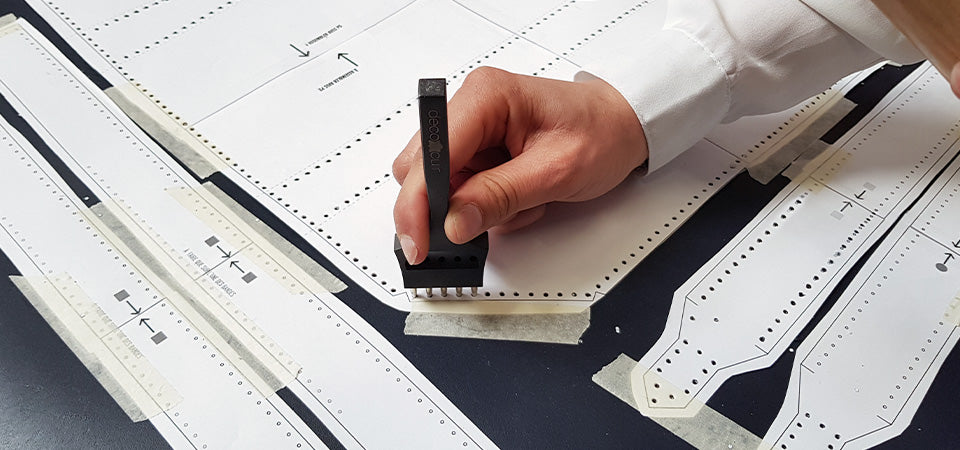
3. CUT THE LEATHER PIECES
Cut out the leather pieces with a cutter following the pattern lines. Reminder : do not pierce or cut pieces P8 and P7 (large model) / P6 and P7 (small model) which will be doubled in step 6. 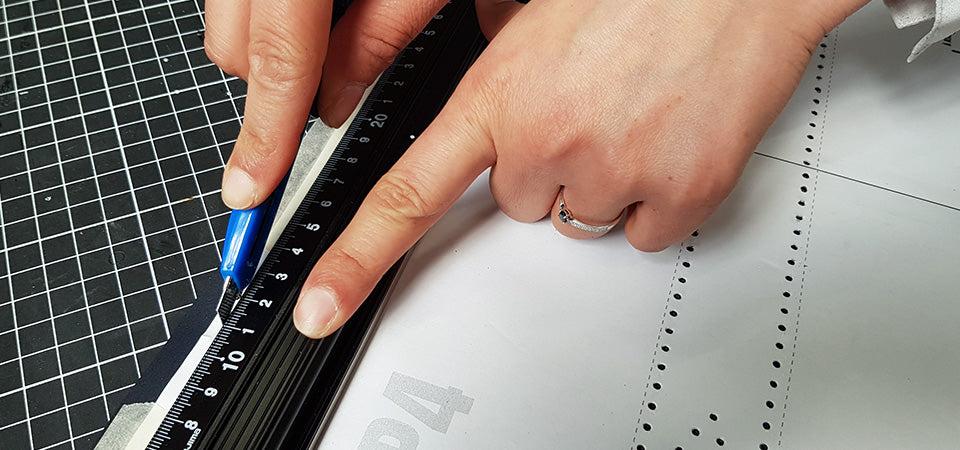
4. MAKE THE BAG HANDLES
Apply leather contact glue to the back of the 2 P3 pieces. 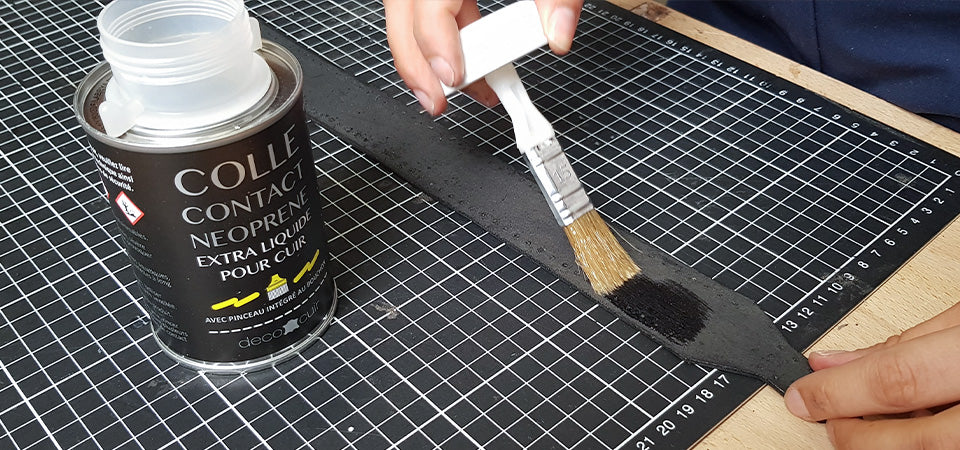
Then, cut out 2 pieces of strand of approximately 54.5 cm and glue them in the center on the back of each P3 piece.
Then, fold the handle back on itself (match the holes). 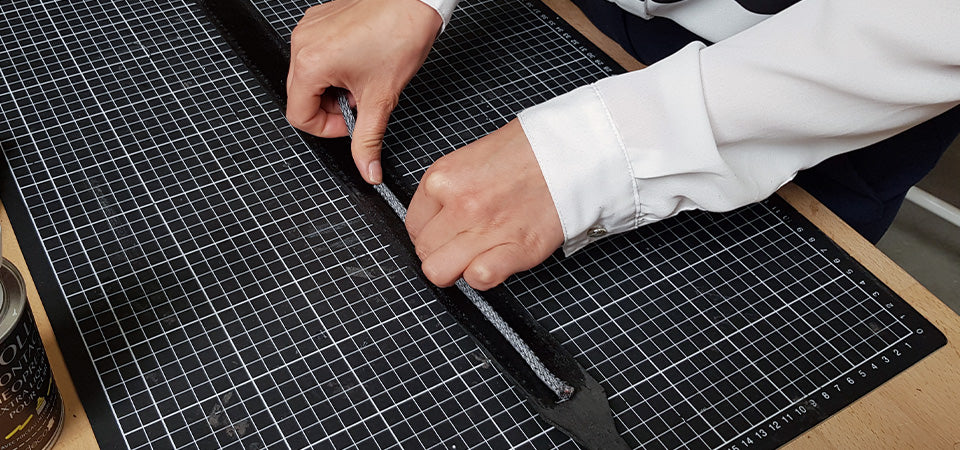
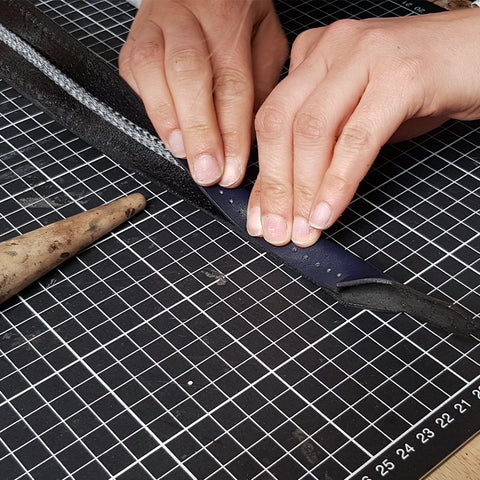 |
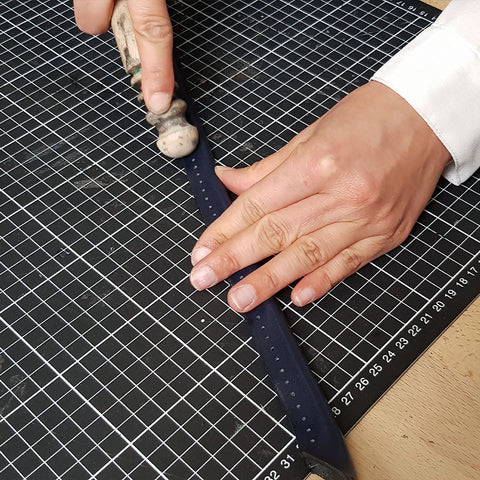 |
Sew the bag handles:
Cut a thread 4 times longer than the length to be sewn. Thread a needle through each end of the thread and begin sewing the handles.
- Pass the thread through the first hole and even out the threads.
- Sew by passing each needle through each hole one by one.
- Finish the seam with 3 double stitches (lock stitches) and trim the threads. To create symmetry, you can start your seam with 3 double stitches.
- Hit the seams with a joiner's hammer or riveter's hammer.
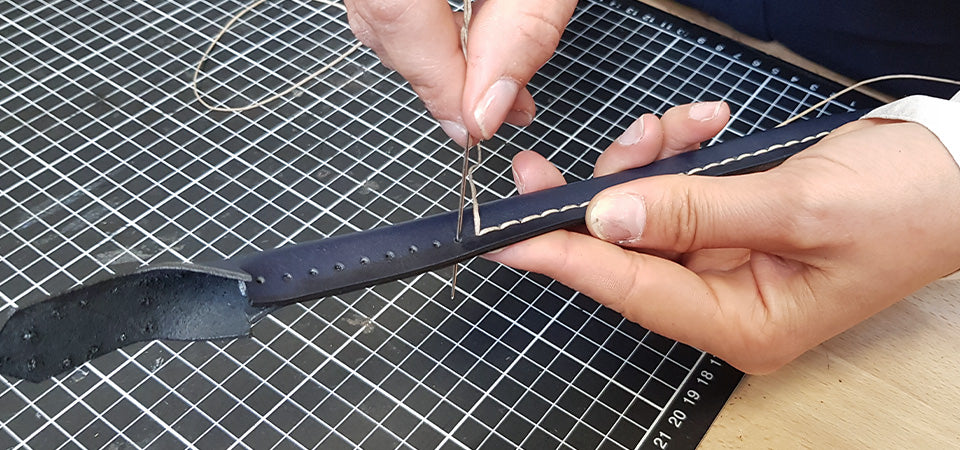
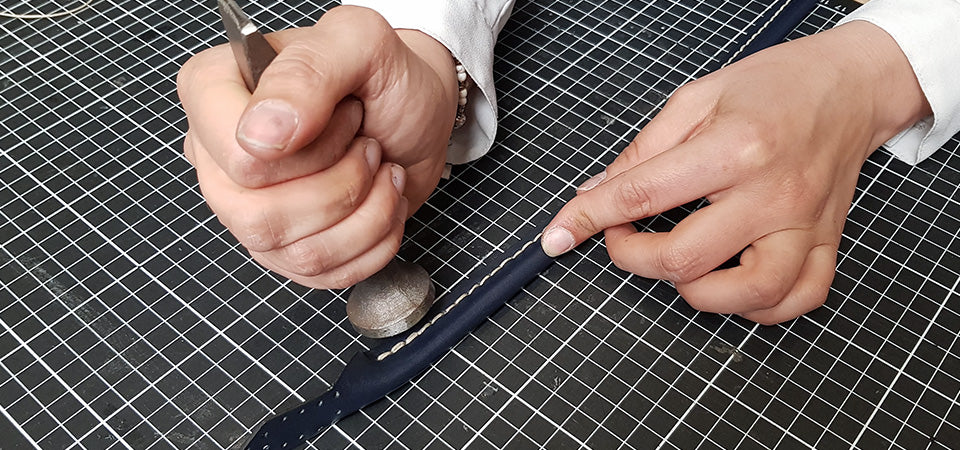
Work the edges of the handles with Tokonole (vegetable tanned leather only) or an edge finish.
TOKONOLE GUIDE >
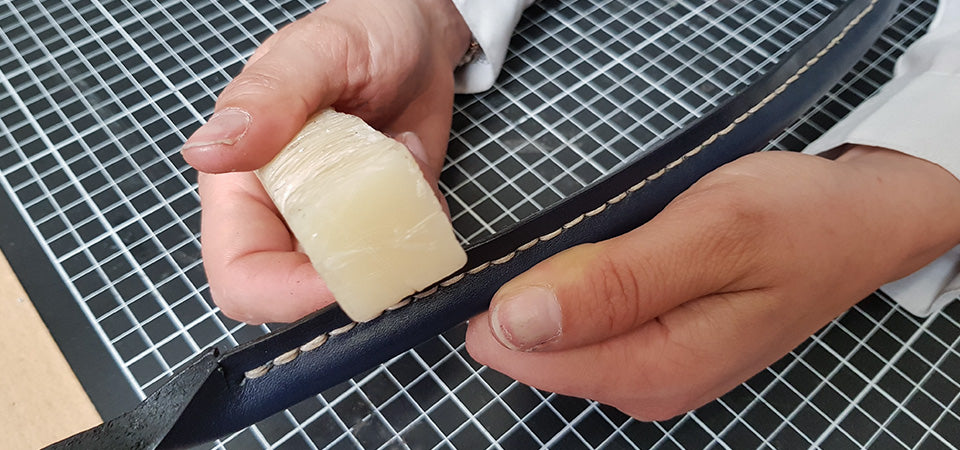
5. WORKING THE DECORATIVE STRIPS
Start by working the edges of the decorative strips with Tokonole or an edge finisher. Using a glue file, scrape the leather where the decorative strips will be glued (to improve the adhesion of the glue) . 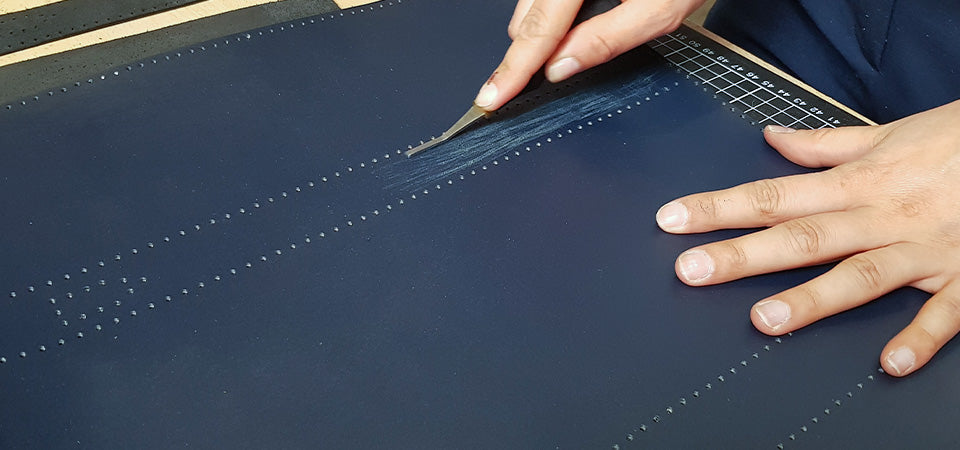
Apply contact adhesive to the back of the straps and the flower of the 2 main pieces of the bag. Then glue the 4 decorative straps. Press/flatten the glue with a roller to achieve good adhesion. 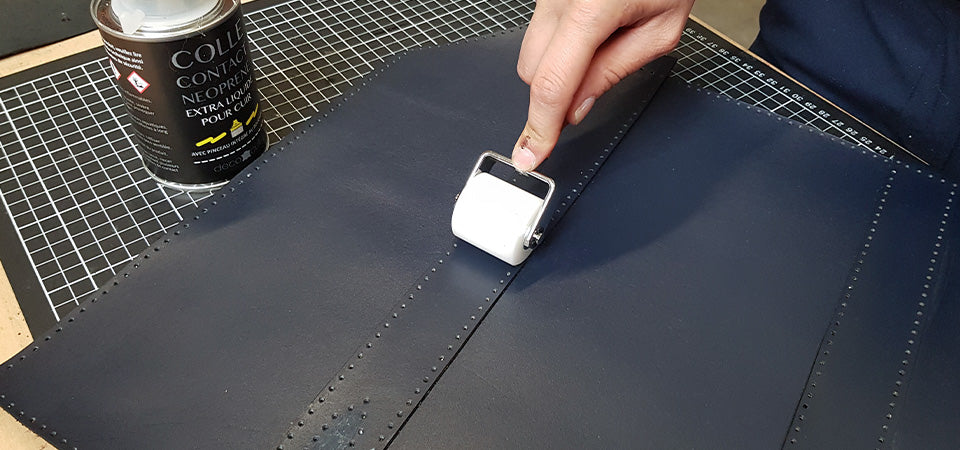
Trim the ends of the excess strips flush. 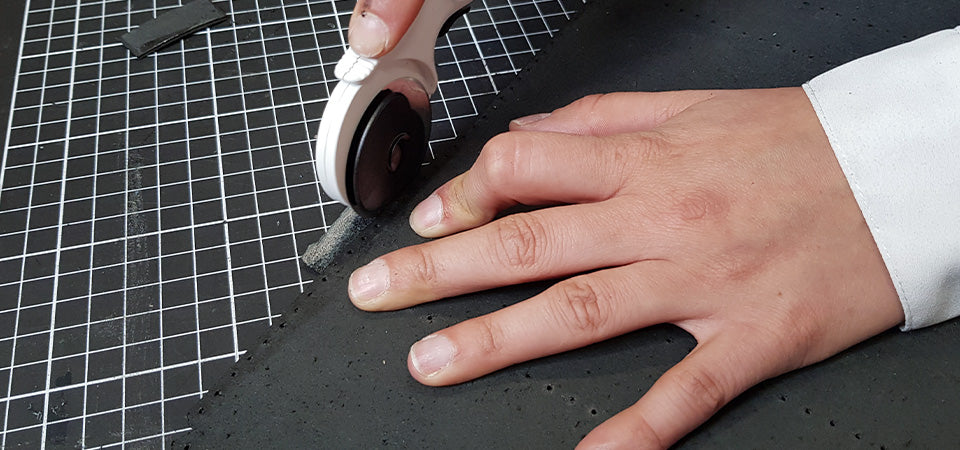
Sew the decorative strips onto the main pieces. Start sewing at the second stitch and finish sewing at the second-to-last stitch (to avoid excess thread thickness during subsequent seams) . 
Finally, sew the bag handles to the designated location on the decorative straps. Double stitch to reinforce the attachment. 
6. GLUING THE PIG VELVET LINING
Tips before gluing the lining:
 |
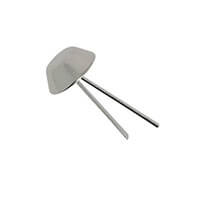 |
| If the leather is not firm enough: glue texon (0.8 mm thick) to the bottom of the bag (P8) before gluing the lining. SEE THE TEXON > |
To prevent the bottom of the bag from getting damaged or dirty: add 4 bag feet to the bottom of the tote bag (P8). SEE THE BAG FEET > |
Glue the lining:
Apply contact glue to the back of the suede pork crust leather and the leather pieces to be lined (P8 and P7 (large model) / P6 and P7 (small model) and the 2 main pieces) then position the leather pieces on the suede crust.
For the two main pieces: do not double up for about 1 cm at the top so that the lining is not visible on the edge when assembling with piece P10 (large model) / P9 (small model) - (see photo no. 2). 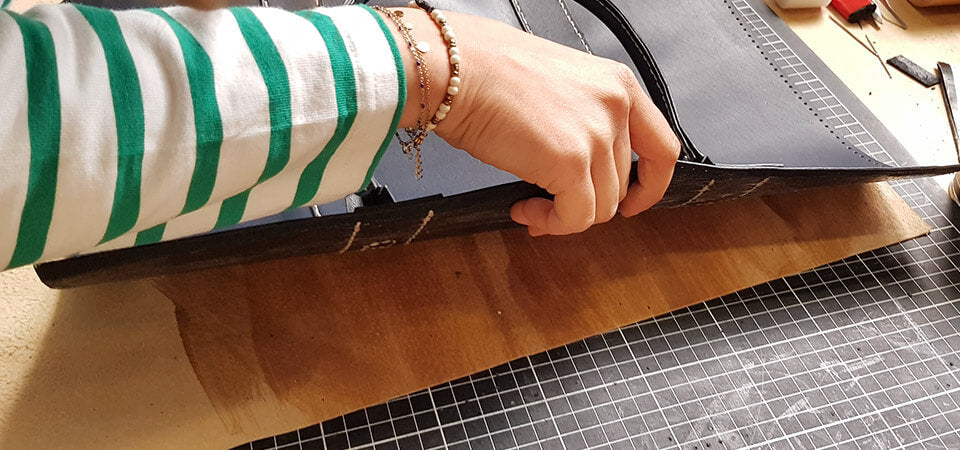
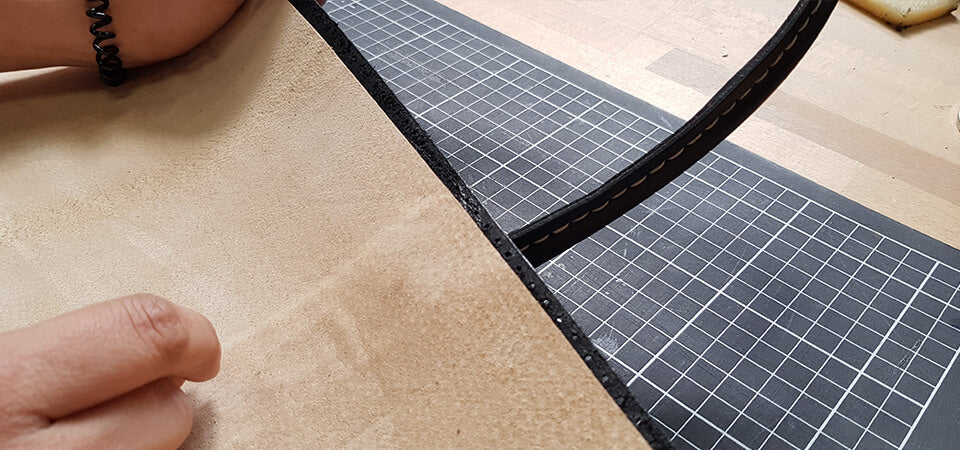
Press/flatten the collage with a roller to obtain good adhesion. 
- Drill the sewing holes of the pieces P8 and P7 (large model) / P6 and P7 (small model) left aside in step 2 then cut them out.
- Re-drill the seam holes in both main pieces and trim the excess lining with a rotary cutter.
For the main pieces, we chose to sew the decorative strips before lining them. It is entirely possible to proceed in the same way as for pieces P8 and P7 (large model) / P6 and P7 (small model) so as not to have to re-drill the holes ( the stitching of the strips will however be visible) .
 |
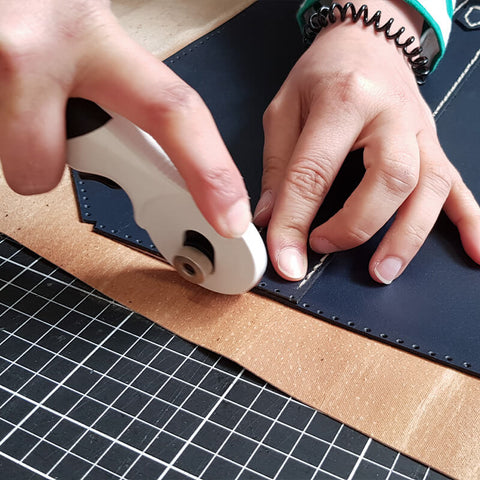 |
7. WORKING THE LEATHER SLICES
Work the edges of all pieces with Tokonole (vegetable tanned leather only) or an edge finish. 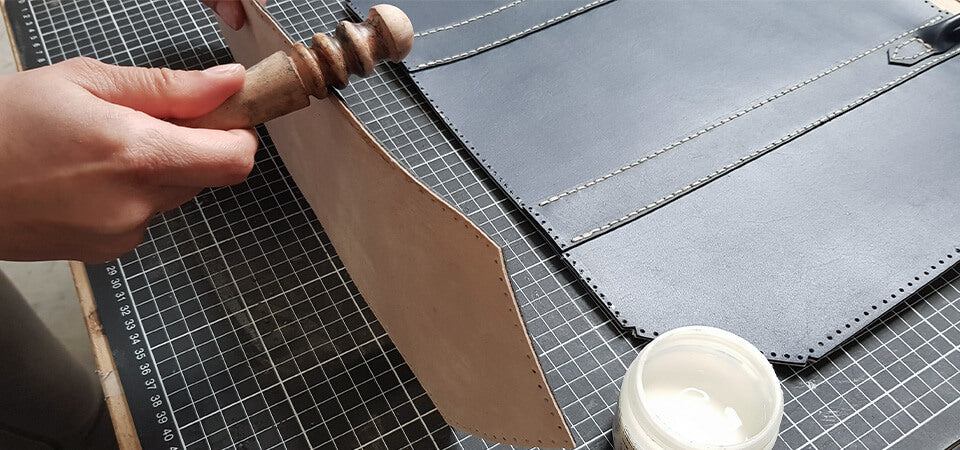
8. ASSEMBLE THE BOTTOM OF THE BAG
Glue the bottom of the bag over the main pieces with leather glue. 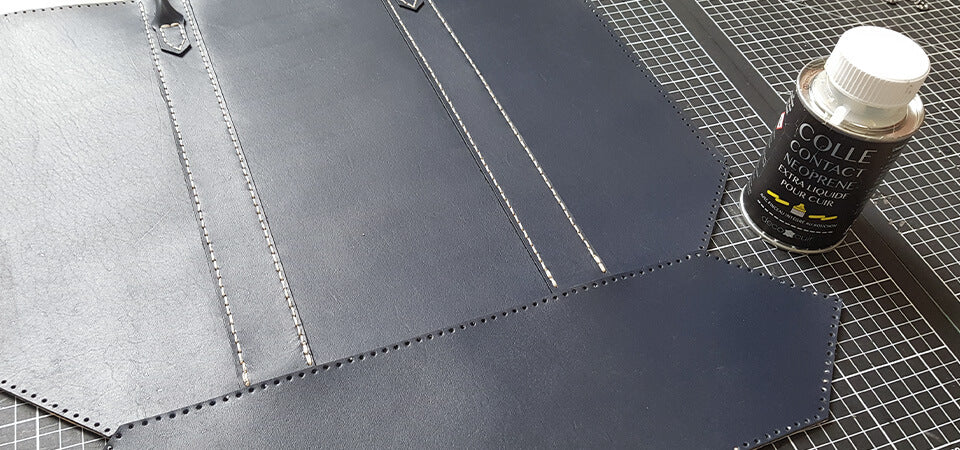
Then, sew the bottom of the bag onto the main pieces.
Tip: If the needles have difficulty passing through the holes, use a round awl to enlarge them. 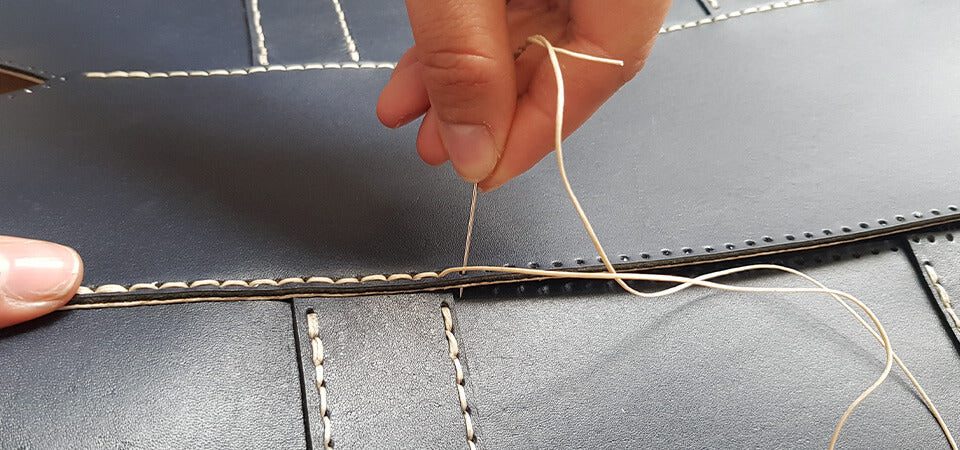
9. MAKE THE INSIDE POCKET
P6 & P7 (large model) / P5 & P6 (small model)
To close the pocket: place two press studs using the appropriate tool or place magnetic tops.
 |
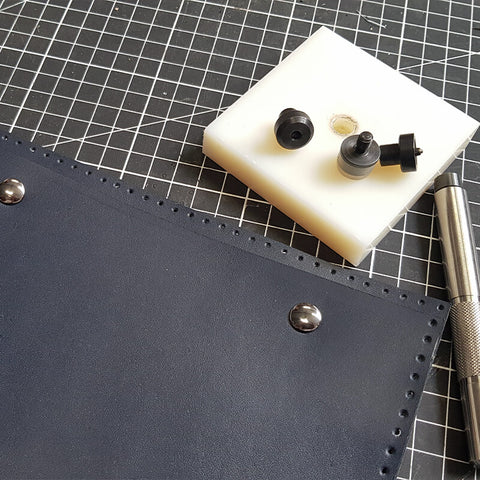 |
- Sew piece P7 to P6 (large model) / P6 to P5 (small model)
- Then rework the slices of the pocket.
- Then sew the top of the pocket (P6 - large model) (P5 - small model) to the place provided on P10 (large model) / P9 (small model).
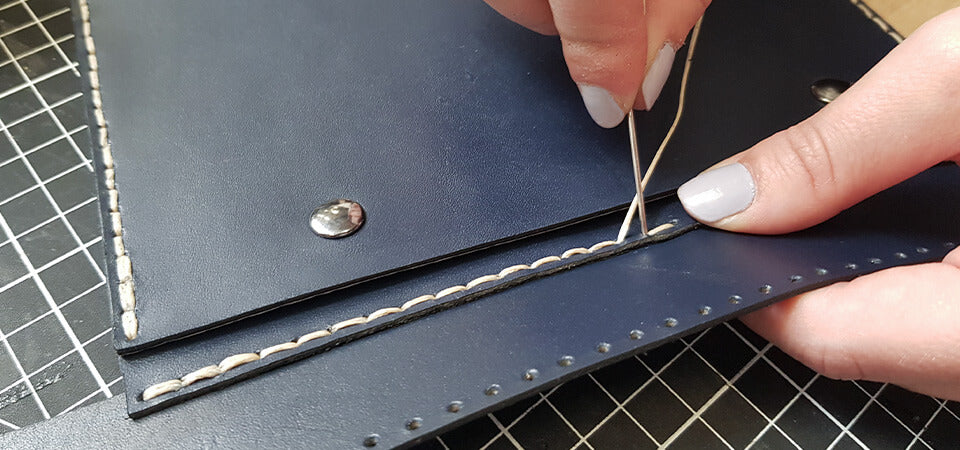
Wax the reverse side (the crust side) of the pocket with Tokonole to reduce the fuzzy appearance of the leather. 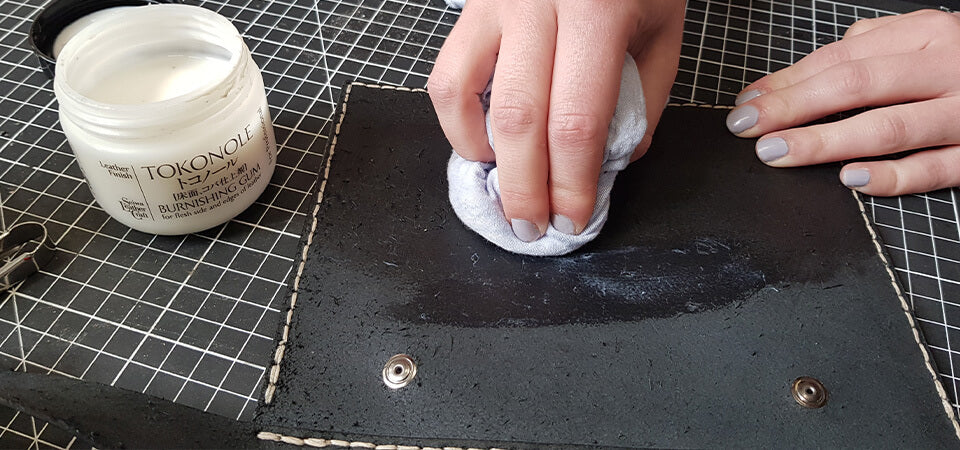
Sew the 2 pieces P10 (large model) / P9 (small model) together.
Option: to be able to close the tote bag, it is possible to place 2 magnetic tops or press studs on each piece at this stage. 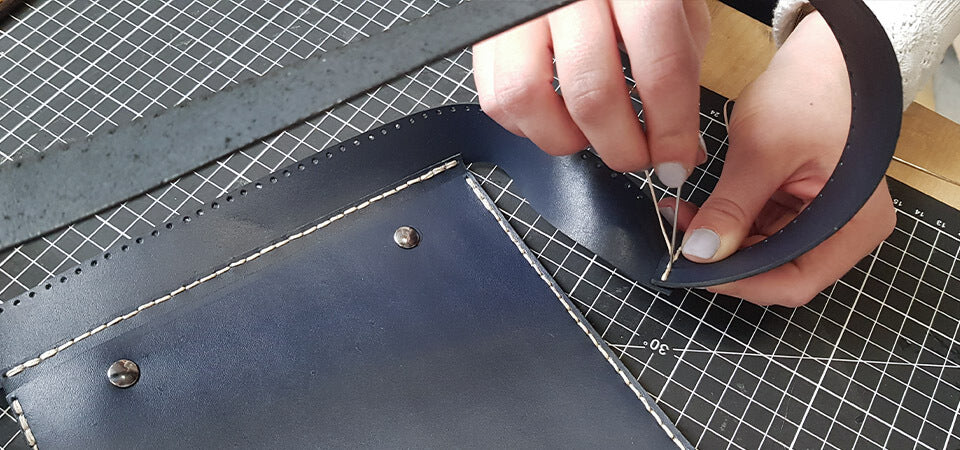
10. SEW THE SIDES OF THE TOTE BAG
Sew the sides of the tote bag: one of the main pieces should be positioned on top of the other. 
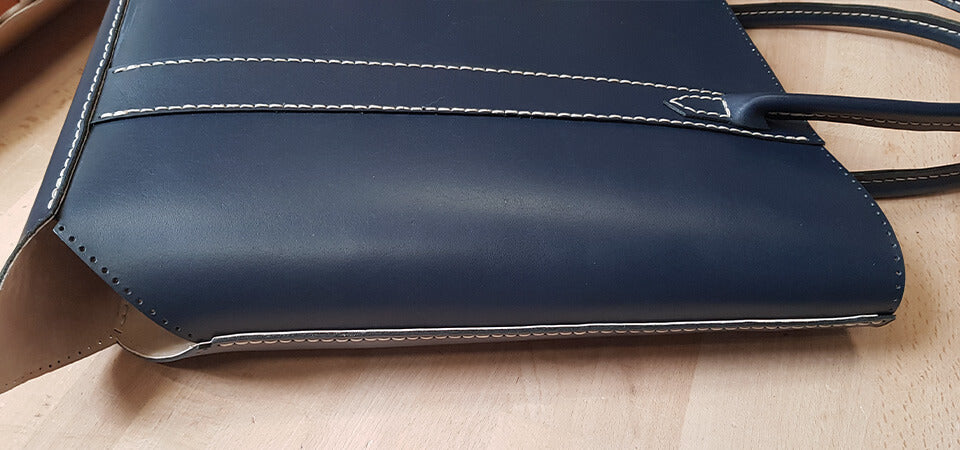
11. SEW THE TRIANGLES
Sew the bottom on each side (triangles).
Please note, the hole at the top of each triangle must go through all 3 layers of leather (see photo). 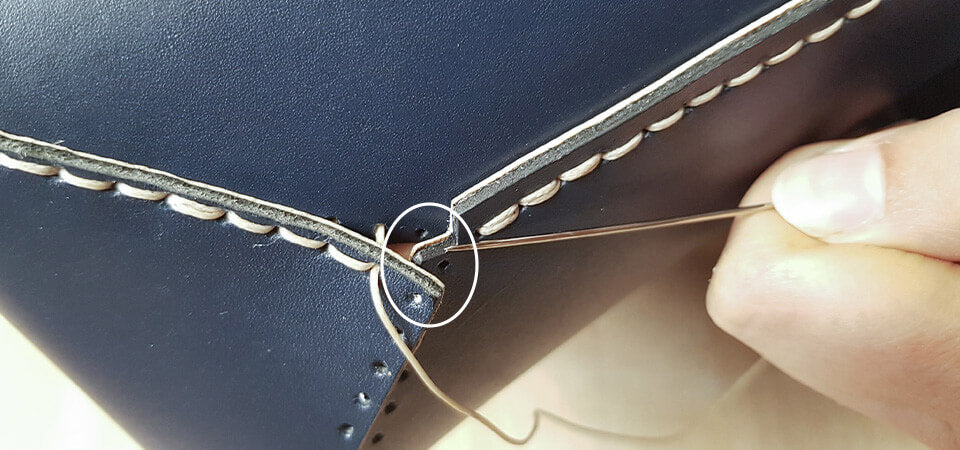
12. SEW THE STRAP TO THE TOP OF THE BAG
Sew piece P10 (large model) / P9 (small model) to the top of the tote bag. Be careful to position the sides correctly so that the pocket is centered.  Work the top edges of the bag. Sand with an abrasive sponge to even out the edge, then apply Tokonole or an edge finish.
Work the top edges of the bag. Sand with an abrasive sponge to even out the edge, then apply Tokonole or an edge finish. 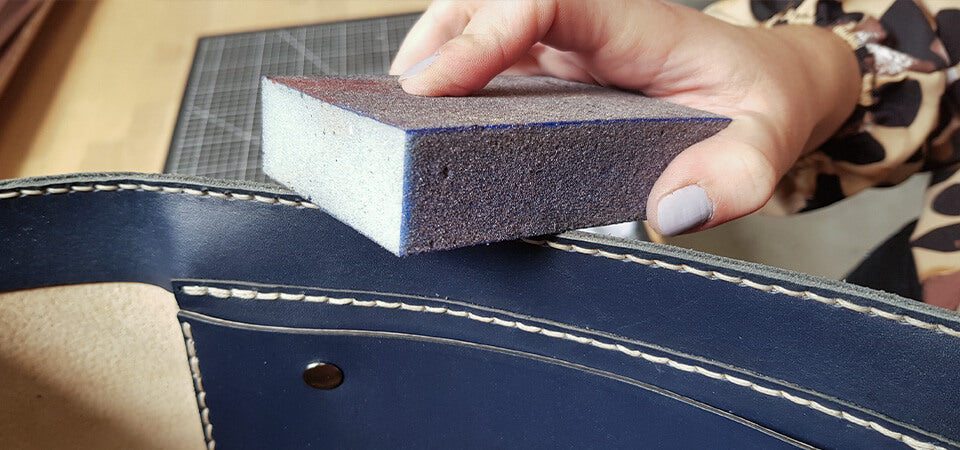
YOUR TOTE BAG IS FINISHED!
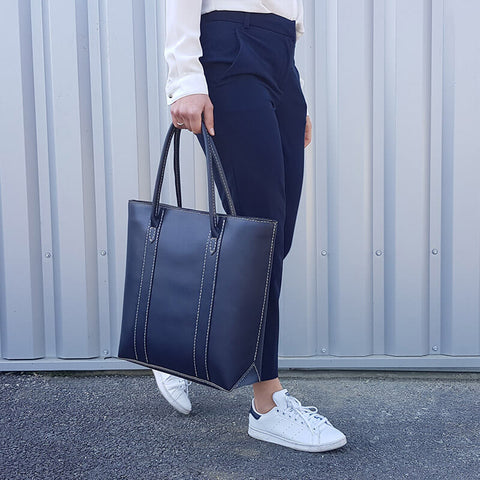 |
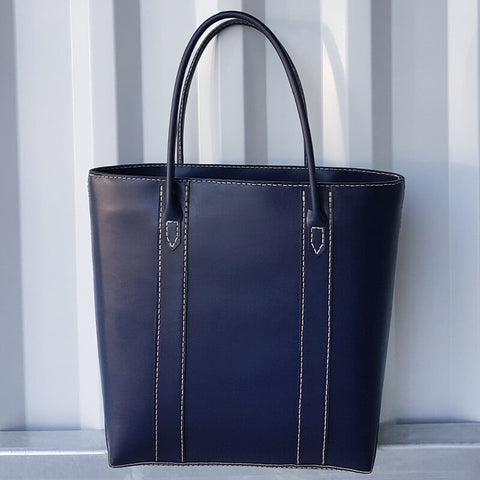 |
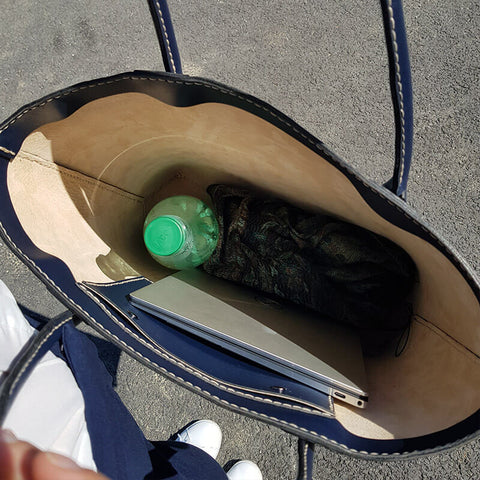 |
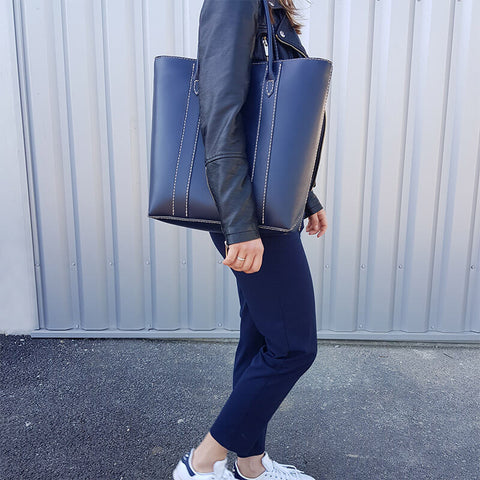 |
DON'T HESITATE TO PIN THE PHOTOS ON PINTEREST TO SHARE THE ARTICLE!
